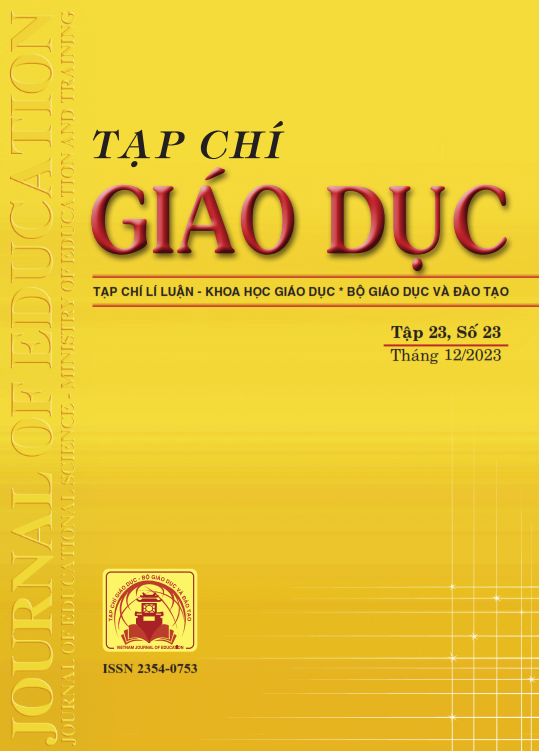Ảnh hưởng của phong cách lãnh đạo chuyển đổi đến sự sáng tạo của nhân viên: nghiên cứu tại các trường cao đẳng công lập Thành phố Hồ Chí Minh
Tóm tắt
Improving the quality of training is an urgent issue in which the teaching staff plays an extremely important core role. This research focuses on the influence of transformational leadership style on employee creativity using a linear structural model. The study was conducted using qualitative and quantitative methods with a sample size of 300 employees working at 18 public colleges in Ho Chi Minh City. The research results can provide managers at public colleges with a more detailed insight into their unit's strengths and weaknesses. Consequently, there will be supportive, incentive and intervention policies to encourage as well as maintain creativity for school staff to gradually regain their recruitment advantages and reputation from neighboring institutions.
Tài liệu tham khảo
Amabile, T. M. (1983). The social psychology of creativity. New York: Springer-Verlag.
Amabile, T. M. (1996). Creativity and innovation in organizations. Harvard Business School.
Amabile, T. M., Conti, R., Coon, H., Lazenby, J., & Herron, M. (1996). Assessing the work environment for creativity. Academy of Management Journal, 39(5), 1154-1184. https://doi.org/10.2307/256995
Bandura, A. (1997). Self-efficacy: The exercise of control. New York: W. H. Freeman.
Bass, B. M. (1985). Leadership and performance beyond expectations. New York: Free Press.
Castiglione, J. (2008). Facilitating employee creativity in the library environment: An important managerial concern for library administrators. Library Management, 29(3), 159-172. https://doi.org/10.1108/01435120810855296
Černe, M., Nerstad, C. G. L., Dysvik, A., & Škerlavaj, M. (2014). What goes around comes around: knowledge hiding, perceived motivational climate, and creativity. Academy of Management Journal, 57(1), 172-192.
Charbonnier-Voirin, A., & Roussel, P. (2012). Adaptive performance: A new scale to measure individual performance in organizations. Canadian Journal of Administrative Sciences, 29(3), 280-293. https://doi.org/10.1002/cjas.232
Diliello, T. C., Houghton, J. D., & Dawley, D. (2011). Narrowing the creativity gap: The moderating effects of perceived support for creativity. The Journal of Psychology, 145(3), 151-172.
Gong, Y., Huang, J., & Farh, J. (2009). Employee learning orientation, transformational leadership, and employee creativity: The mediating role of employee creative self-efficacy. Academy of Management Journal, 52, 765-778.
Jacobs, T. O. (1970). Leadership and Exchange in Formal Organizations. Human Resources Research Organization.
Janda, K. F. (1960). Towards the explication of the concept of leadership in terms of the concept of power. Human Relations, 13(4), 345-363. https://doi.org/10.1177/001872676001300404
Jung, D. I., & Sosik, J. J. (2002). Transformational leadership in work groups: The role of empowerment, cohesiveness, and collective-efficacy on perceived group performance. Small Group Research, 33(3), 313-336. https://doi.org/10.1177/10496402033003002
Moolenaar, N. M., Daly, A. J., Sleegers, P. J. C. (2010). Occupying the principal position: Examining relationships between transformational leadership, social network position, and schools’ innovative climate. Educational Administration Quarterly, 46(5), 623-670. https://doi.org/10.1177/0013161X10378689
Mumford, M. D., & Gustafson, S. B. (1988). Creativity syndrome: Integration, application, and innovation. Psychological Bulletin, 103(1), 27-43. https://doi.org/10.1037/0033-2909.103.1.27
Mumford, M. D., Scott, G. M., Gaddis, B., & Strange, J. M. (2002). Leading creative people: Orchestrating expertise and relationships. The Leadership Quarterly, 13(6), 705-750. https://doi.org/10.1016/S1048-9843(02)00158-3
Nguyễn Đình Thọ, Nguyễn Thị Mai Trang (2011). Nghiên cứu khoa học marketing - Ứng dụng mô hình cấu trúc tuyến tính SEM. NXB Lao động.
Oldham, G. R., & Cummings, A. (1996). Employee creativity: Personal and contextual factors at work. Academy of Management Journal, 39(3), 607-634. https://doi.org/10.2307/256657
Rauch, C. F., & Behling, O. (1984). Functionalism: Basis for an Alternate Approach to the Study of Leadership. Leaders and Managers: International Perspectives on Managerial Behavior and Leadership, 45-62.
Schein, E. H. (1992). Organizational culture and leadership (2nd ed). San Francisco: Jossey-Bass.
Scott, S. G., & Bruce, R. A. (1994). Determinants of innovative behavior: A path model of individual innovation in the workplace. Academy of Management Journal, 37(3), 580-607. https://doi.org/10.2307/256701
Sendjaya, S., Sarros, J. C., & Santora, J. C. (2008). Defining and measuring servant leadership behaviour in organizations. Journal of Management Studies, 45(2), 402-424. https://doi.org/10.1111/j.1467-6486.2007.00761.x
Shalley, C. E. (1991). Effects of productivity goals, creativity goals, and personal discretion on individual creativity. Journal of Applied Psychology, 76(2), 179-185. https://doi.org/10.1037/0021-9010.76.2.179
Shalley, C. E., Zhou, J., & Oldham, G. R. (2004). The Effects of Personal and Contextual Characteristics on Creativity: Where Should We Go from Here? Journal of Management, 30(6), 933-958. https://doi.org/10.1016/j.jm.2004.06.007
Tannenbaum, R. J., Weschler, I. R., & Massarik, F. (1961). Leadership and organization: A behavioral science approach. McGraw-Hill.
Tierney, P., & Farmer, S. M. (2002). Creative self-efficacy: Its potential antecedents and relationship to creative performance. Academy of Management Journal, 45(6), 1137-1148. https://doi.org/10.2307/3069429
Tierney, P., & Farmer, S. M. (2011). Creative self-efficacy development and creative performance over time. Journal of Applied Psychology, 96(2), 277-293. https://doi.org/10.1037/a0020952
Tierney, P., Farmer, S. M., & Graen, G. B. (1999). An examination of leadership and employee creativity: The relevance of traits and relationships. Personnel Psychology, 52(3), 591-620. https://doi.org/10.1111/j.1744-6570.1999.tb00173.x
Treviño, L. K., Butterfield, K. D., & McCabe, D. L. (2001). The ethical context in organizations: Influences of employee attitudes and behaviors. In J. Dienhart, D. Moberg, & R. Duska (Eds.), The next phase of business ethics: Integrating psychology and ethics (pp. 301-337).
Wang, P., & Rode, J. C (2013). Transformational leadership and follower creativity: The moderating effects of identification with leader and organizational climate. Human Relations, 63(8), 1105-1128. https://doi.org/10.1177/0018726709354132
Woodman, R. W., Sawyer, J. E., & Griffin, R. W. (1993). Toward a theory of organizational creativity. Academy of Management Review, 18(2), 293-321. https://doi.org/10.2307/258761
Yukl, G. (2010). Leadership in Organizations. Upper Saddle River, NJ: Pearson.
Zhou, J., & George, J. M. (2003). Awakening employee creativity: The role of leader emotional intelligence. The Leadership Quarterly, 14(4-5), 545-568. https://doi.org/10.1016/S1048-9843(03)00051-1
Zhou, J., & Shalley, C. E. (2003). Research on employee creativity: A critical review and directions for future research. In Research in personnel and human resources management (pp. 165-217). Emerald Group Publishing Limited. https://doi.org/10.1016/S0742-7301(03)22004-1
Tải xuống
Đã Xuất bản
Cách trích dẫn
Số
Chuyên mục
Giấy phép

Tác phẩm này được cấp phép theo Ghi nhận tác giả của Creative Commons Giấy phép quốc tế 4.0 .












